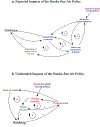Using systems science to advance health equity in tobacco control: a causal loop diagram of smoking
- PMID: 34535509
- PMCID: PMC9466654
- DOI: 10.1136/tobaccocontrol-2021-056695
Using systems science to advance health equity in tobacco control: a causal loop diagram of smoking
Abstract
Objectives: Develop and use a causal loop diagram (CLD) of smoking among racial/ethnic minority and lower-income groups to anticipate the intended and unintended effects of tobacco control policies.
Methods: We developed a CLD to elucidate connections between individual, environmental and structural causes of racial/ethnic and socioeconomic disparities in smoking. The CLD was informed by a review of conceptual and empirical models of smoking, fundamental cause and social stress theories and 19 qualitative interviews with tobacco control stakeholders. The CLD was then used to examine the potential impacts of three tobacco control policies.
Results: The CLD includes 24 constructs encompassing individual (eg, risk perceptions), environmental (eg, marketing) and structural (eg, systemic racism) factors associated with smoking. Evaluations of tobacco control policies using the CLD identified potential unintended consequences that may maintain smoking disparities. For example, the intent of a smoke-free policy for public housing is to reduce smoking among residents. Our CLD suggests that the policy may reduce smoking among residents by reducing smoking among family/friends, which subsequently reduces pro-smoking norms and perceptions of tobacco use as low risk. On the other hand, some residents who smoke may violate the policy. Policy violations may result in financial strain and/or housing instability, which increases stress and reduces feelings of control, thus having the unintended consequence of increasing smoking.
Conclusions: The CLD may be used to support stakeholder engagement in action planning and to identify non-traditional partners and approaches for tobacco control.
Keywords: disparities; priority/special populations; public policy.
© Author(s) (or their employer(s)) 2023. No commercial re-use. See rights and permissions. Published by BMJ.
Conflict of interest statement
Competing interests: Not required.
Figures
References
-
- Drope J, Liber AC, Cahn Z, et al. Who’s still smoking? Disparities in adult cigarette smoking prevalence in the United States. CA Cancer J Clin 2018;68(2):106–15. - PubMed
-
- National Cancer Institute. Greater than the sum: Systems thinking in tobacco control. Tobacco Control Monograph No. 18. 2007. https://cancercontrol.cancer.gov/brp/tcrb/monographs/monograph-18 (accessed August 4 2021).
Publication types
MeSH terms
Substances
Grants and funding
LinkOut - more resources
Full Text Sources
Medical



